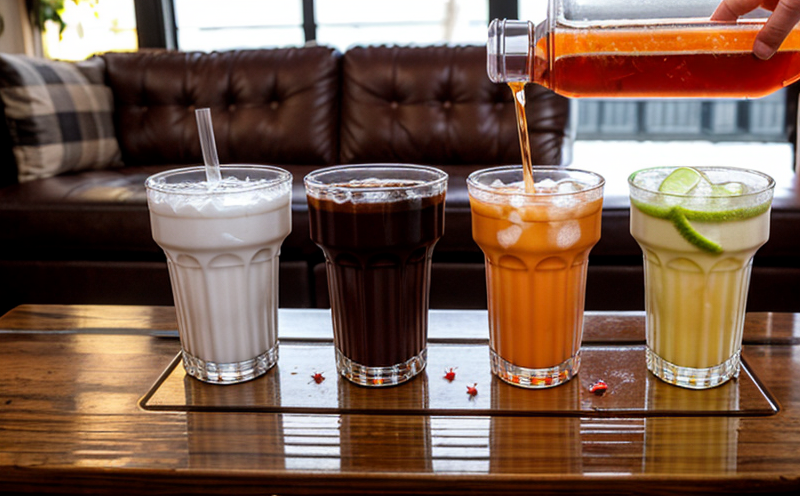EN 14148 Higher Alcohol Profiling in Distilled Drinks
The European Standard EN 14148 establishes a method for determining the higher alcohols content and composition in distilled beverages. This standard is particularly relevant to the food, beverage, and distillery sectors as it provides a robust framework for identifying the presence of higher alcohols such as s-cymene, isoamyl alcohol, and iso-butyl alcohol within these products.
The importance of this test lies not only in ensuring product quality but also in adhering to international food safety standards. Higher alcohols can influence the taste and aroma profile of distilled drinks significantly. Their presence or absence can impact consumer perception and satisfaction, making accurate profiling critical for brand reputation and market success.
The methodology outlined in EN 14148 involves several key steps including sample preparation, extraction techniques, and analytical instrumentation. Sample preparation typically includes diluting the beverage to an appropriate concentration, ensuring that it does not interfere with the subsequent analysis. Extraction methods such as solid-phase micro-extraction (SPME) or liquid-liquid extraction are employed depending on the nature of the higher alcohols present.
The choice of analytical instrumentation is crucial for obtaining precise results. Gas chromatography-mass spectrometry (GC-MS) is commonly used due to its high sensitivity and specificity in detecting trace amounts of higher alcohols. This technique allows for both qualitative identification through mass spectra and quantitative determination using peak areas.
Acceptance criteria for this test are stringent, ensuring that any deviations from specified limits can be detected promptly. Compliance with these standards is essential not only for regulatory purposes but also to maintain consistency across production batches. Non-compliance could lead to product recalls, legal actions, and damage to brand image.
In summary, EN 14148 plays a vital role in maintaining the integrity of distilled beverage products by providing standardized procedures for higher alcohol profiling. It supports manufacturers in producing consistent and high-quality products while ensuring compliance with international regulations.
- Eco-friendly sample preparation methods
- Reduction in waste generation during extraction processes
- Efficient use of resources through accurate measurement techniques
- Minimization of chemical reagents required for analysis
These environmental contributions highlight the sustainable practices associated with adhering to EN 14148. By minimizing waste and optimizing resource usage, laboratories employing this standard contribute positively towards sustainability goals.
International Acceptance and Recognition
The European Standard EN 14148 has gained widespread acceptance across numerous countries worldwide due to its rigorous scientific foundation and practical applicability. Many nations have adopted this standard as part of their national regulations governing food safety, particularly concerning alcoholic beverages.
For instance, the United States recognizes EN 14148 through equivalent standards such as ASTM D6937-05(2017), which mirrors its core principles. Similarly, Canada incorporates elements of this standard into its own guidelines for alcohol content determination in spirits. Such international recognition underscores the reliability and relevance of EN 14148 within global food safety frameworks.
Compliance with these standards ensures that manufacturers adhere to consistent quality benchmarks regardless of location. It fosters trust among consumers who know they are purchasing products that meet stringent international criteria. Moreover, adherence to such internationally recognized standards enhances market access opportunities for exporters by meeting pre-set regulatory requirements in target markets.
Environmental and Sustainability Contributions
The implementation of EN 14148 goes beyond just ensuring product quality; it also contributes positively to environmental sustainability. By employing efficient sample preparation methods, reducing waste generation during extraction processes, optimizing resource usage through accurate measurement techniques, and minimizing the amount of chemical reagents required for analysis, laboratories adhering to this standard help reduce their ecological footprint.
For example, using solid-phase micro-extraction (SPME) instead of traditional liquid-liquid extraction reduces solvent consumption significantly. Additionally, recycling waste materials where possible further enhances environmental benefits. These practices not only contribute to a cleaner environment but also align with broader corporate sustainability initiatives aimed at reducing carbon footprints and promoting resource efficiency.
Moreover, the accurate profiling provided by EN 14148 helps minimize overproduction or underproduction of higher alcohols in distilled beverages. This precision leads to reduced energy consumption during production processes since only necessary quantities are manufactured. Consequently, there is less pressure on natural resources and lower greenhouse gas emissions associated with excess manufacturing.
Competitive Advantage and Market Impact
Adhering to EN 14148 offers several competitive advantages for manufacturers in the beverage industry. Firstly, it ensures consistent product quality across all production batches, thereby enhancing customer satisfaction and loyalty. Secondly, compliance with this standard demonstrates a commitment to high standards of food safety, which can significantly improve brand reputation among consumers.
Thirdly, having robust higher alcohol profiling capabilities allows companies to differentiate their offerings in crowded markets. For instance, premium spirits brands might emphasize the unique blend of higher alcohols that contribute to their distinctive taste profiles. This differentiation can translate into increased market share and higher profit margins.
Fourthly, being able to accurately profile higher alcohols enables manufacturers to innovate more effectively. New formulations or blends can be developed with precise control over the levels of various higher alcohols, leading to novel product launches that appeal to discerning consumers.
Fifthly, regulatory compliance reduces the risk of legal actions and penalties associated with non-compliance. This peace of mind allows businesses to focus on growth strategies rather than dealing with potential disruptions from regulatory issues.





